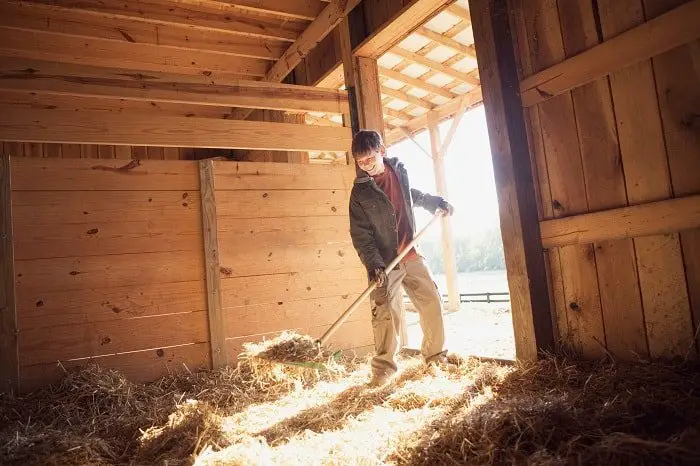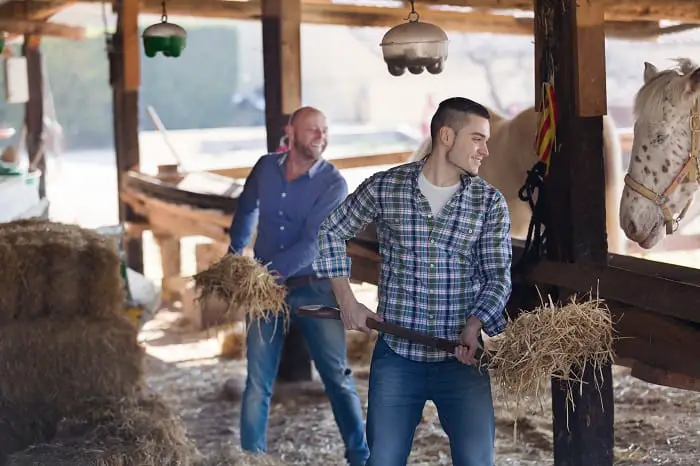How Many Flakes of Hay Do You Feed a Horse Per Day
Last Updated on December 17, 2021 by
Ever get sick of hauling hay bales around the barn? Hay can be messy, itchy, and expensive. What if there was another way for your horses to receive the same nutrients they would get in hay flakes, without all the hassle? Lets talk about hay cubes.
Look no further than cubes! Hay cubes, typically made out of Alfalfa hay, are a compressed, dehydrated form of hay. You're still feeding your horse hay, but it's less messy, less wasteful, and less expensive!
There are many pros and cons of both hay and cubes, which I will discuss throughout this article. I will also discuss standard feeding quantities of hay and of cubes, and how to convert measurements of one into measurements of the other.
Hay Cubes, Compare and Contrast
All horse owners could tell you what it is like to deal with a bale of hay. Bales of hay are heavy, messy, and itchy. You end up dropping a third of the flake on the ground before it makes it into your horse's stall. Your horse mixes a third of it into his shavings, and maybe a third of the bale actually makes it into your horse's digestive tract.
Then, you have to go back and sweep the aisle where the first third of the flake fell! Flakes of hay are messy, wasteful, and can be very expensive. But, they provide the horse with the necessary nutrients.

Cubes typically come in bags, just like grain or oats. They are easy to transport and can be purchased at any feed store; they don't have to come directly from a farmer, as bales of hay do. Bags of cubes typically weigh up to 50 lbs, which can provide enough forage for a horse for a week or so.
Sometimes, because cubes are dehydrated, horses choke on them or have trouble chewing them. Cubes are very dry and can cause issues with sensitive of senior horses. But, cubes can be wetted down.
Soaking cubes can provide horses with the moisture they need to better swallow and digest the cubes. It turns the cubes into almost a hay mash. Especially when soaked with warm water, horses typically love eating their hay like this.
Hay Cubes, Standard Feeding Quantities
Whether you feed hay flakes or cubes, it is important that your horse is being provided with a healthy, correct quantity of feed. Horses on cubes tend to overeat more than horses on hay flakes. So, it is especially important to make sure horses on cubes are receiving the correct quantity of feed.
Generally, it is correct to feed a horse 1% of their body weight in forage (so excluding any grain, oats, supplements, etc.) daily.
|
Hay Flakes
How many flakes of hay to feed a horse? A horse typically gets anywhere from two to four flakes of hay with each meal. That's anywhere from four to eight flakes a day. Obviously the exact number will depend on the horse, their body weight, whether this weight is unhealthy or not (in either direction), and how much access to other forage (such as grass) that the horse has.
Hay flakes typically have the same weight and quantities, because there's only so much you can compress actual strands of hay.
Hay Cubes
Hay cubes, however, can be compressed in varying degrees. Because they are made of dehydrated hay, the amount to which the nutrients are compressed can depend on the quality of the dehydration technique used, as well as other factors.
So, it's hard to say whether there is an exact standard in quantity of cubes . Most, if not all cube manufacturers include a quantity guide on the bags of their cubes. These guides are also available online.
Purina lists how much to feed a standard horse if it's hay is split 50/50 between cubes and flakes. And, it lists how much to feed a standard horse if it's 100% on hay cubes. Notice that the quantities vary based on which particular product is purchased.
This is because different types of hay cubes have different quantities of certain nutrients. Some are denser than others. So, the exact quantity will depend not only on each horse's unique needs but also on which type of cube you decide to purchase.
Conversion Factors
It's hard to say whether there is an exact conversion factor in cubes to hay flakes. The standard to go by is always weight. Determine how many pounds of forage your horse needs to eat a day, and make sure they are getting that, whether it be in hay flakes or cubes.
For example, using Purina's "Horse Feed Calculator" (link below), I estimated that my horse needs 14 or more pounds of forage a day. He gets 6 flakes of hay a day, and he has 10-hour access to grass.
It's averaged that a horse eats a pound of grass for every hour they are exposed to it (so long as it is available). So, about 10 pounds in grass and the 6 flakes of hay makes up for the rest of it.

The same calculation can be done with hay cubes. Let's say my horse didn't have access to grass. If he got two pounds of hay flakes a day, he would need another 12+ pounds of cubes in order to meet his daily needs.
So, there isn't an exact conversion between cubes and hay flakes. Instead, correct quantities are measured by how big your horse is, and what kind of work he is involved in.
The correct quantity of forage for your horse can be calculated using Purina's Horse Feed Calculator at this link.
Conclusion
I hope this article has helped shed some light on the benefits of feeding hay and what the correct quantities of both flakes and cubes are! If so, please share this article, and share with us your experiences feeding with both hay cubes and hay flakes!
FAQs
Alfalfa cubes should be
A hay cube is a hay bale made from hay that has been cut into individual pieces and then compressed into a uniform shape. Hay cubes tend to be easier to digest and more palatable for horses that have sensitive stomachs. Furthermore, the processing, storage, transport, and feeding of cubes are more efficient than conventional hay. The process of cutting cubes from bales can be automated and is not limited by weather conditions, unlike when you harvest hay in the field. Because of their size, there is less waste when cubes are fed than when flakes of hay are fed.
Can you feed horses dry hay cubes?
Hay cubes can be fed either wet or dry but it may be a good idea to wet the cubes when they are first introduced as it will be easier for the horse to chew on them. As soon as the horse get used to hay cubes, they can be fed dry.
The cubes should be kept in a dry and cool place, preferably stored at temperatures of 10 to 15 degrees Celsius. Hay cubes can be fed in conjunction with other forms of roughage such as hay or silage although they are often used as a substitute for the normal ration of hay. In addition to being a great way to add variety to a horse's diet, hay cubes can also be used to help control the weight of the horse.
Are hay cubes bad for horses?
No, hay cubes are not bad for horses but can be a better alternative in many cases. They are a healthy way to feed your horse. Compared to hay, cubes tend to have more consistent levels of vitamins and minerals. For horses with respiratory problems, cubes are a good alternative to hay because they contain less dust than hay. Hay cubes are also easier to feed and produce less waste than loose hay or hay flakes.
Should I feed my horse alfalfa cubes?
Yes, alfalfa cubes are a great source of nutrition for horses. They provide essential vitamins and nutrients that may be lacking from a horse's diet. They are also a good source of protein and fiber. Alfalfa hay contains more protein and fiber than most other hay types.
Alfalfa cubes are best fed in conjunction with other forms of roughage such as hay, silage, or haylage. Alfalfa cubes are also a source of vitamin E, iron, B vitamins, and omega-3 fatty acids. Alfalfa cubes can be used to add variety to the diet of a horse that is malnurished or overworked. They are also a precious source of nutrients for nursing mares and senior horses.
Can alfalfa cubes cause colic?
Because alfalfa is high in fiber, it can be difficult to digest and can increase the risk of colic. Alfalfa cubes may also contain mold or bacteria if not stored properly, which can make your horse ill. Horses should be fed alfalfa cubes with caution. It is advisable to fed alfalfa cubes in combination with other foods as feeding alfalfa in excess can lead to obesity and colic.
If you are considering feeding alfalfa cubes to your horse, ask your vet for a recommendation on how much and what type of alfalfa cubes to feed.
Source: https://www.besthorserider.com/hay-cubes-v-hay-flakes/
0 Response to "How Many Flakes of Hay Do You Feed a Horse Per Day"
ارسال یک نظر